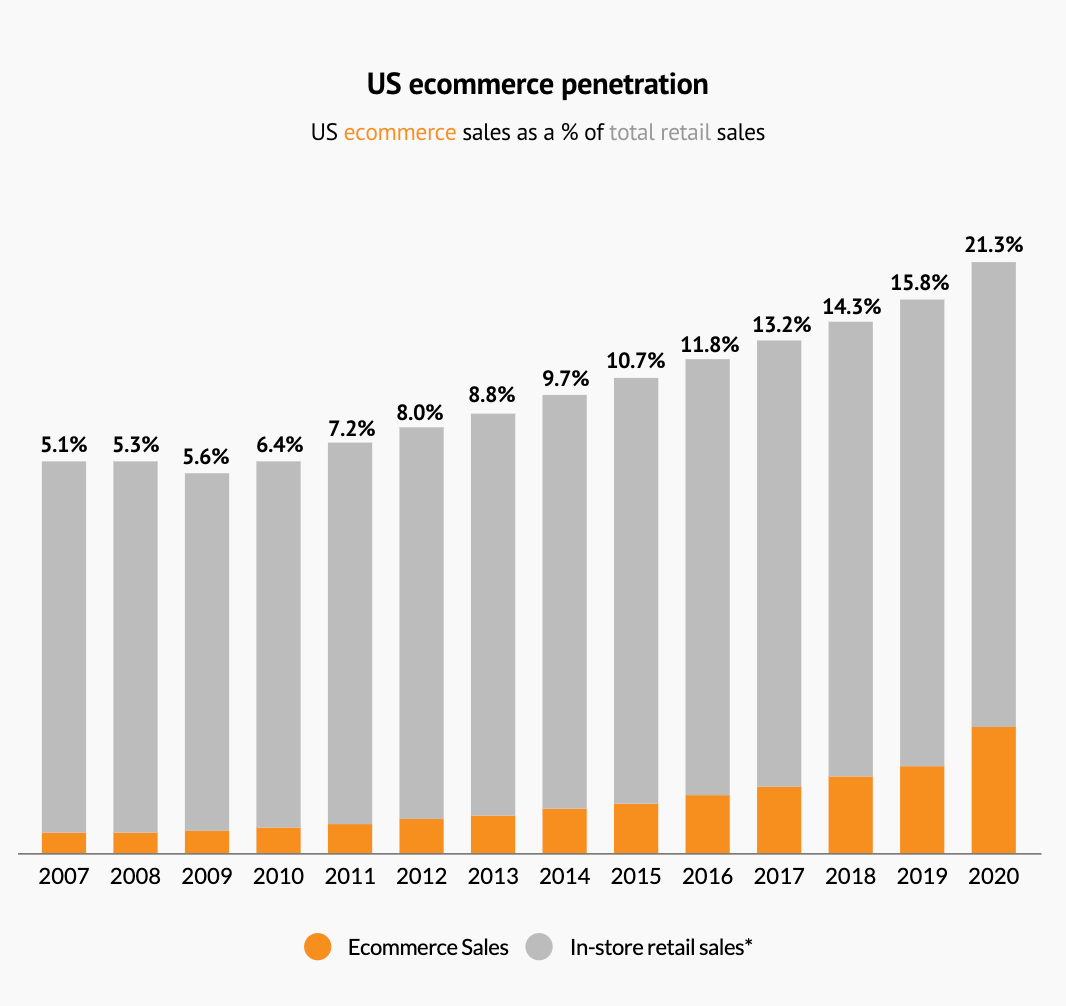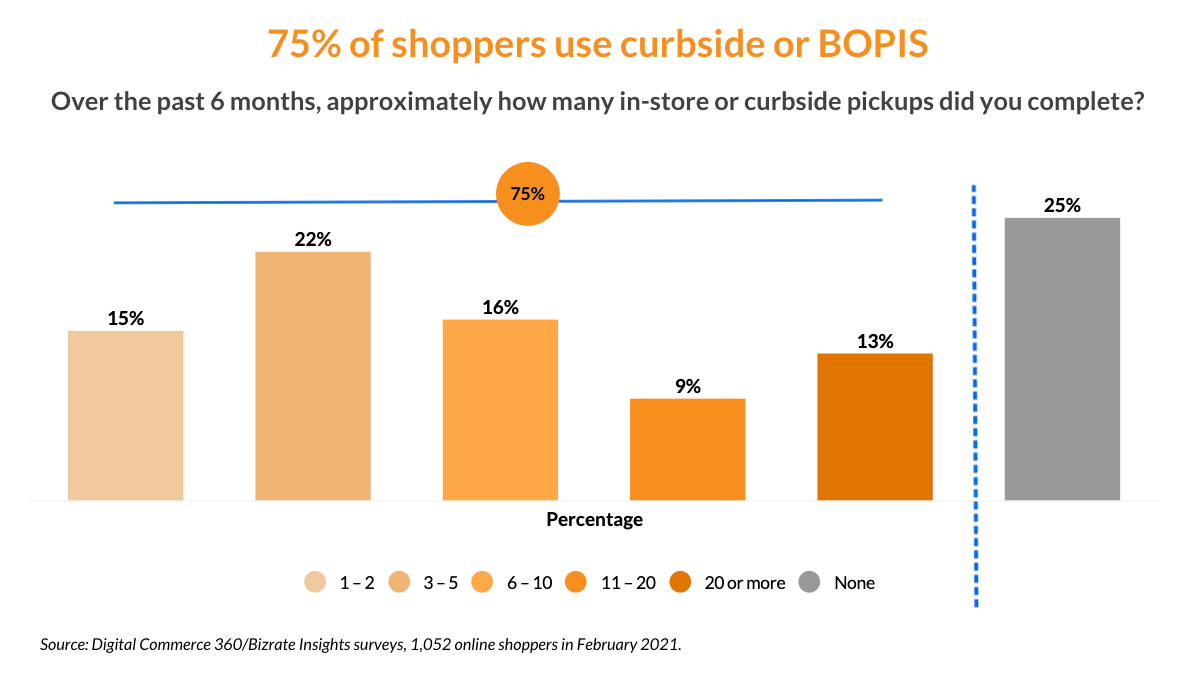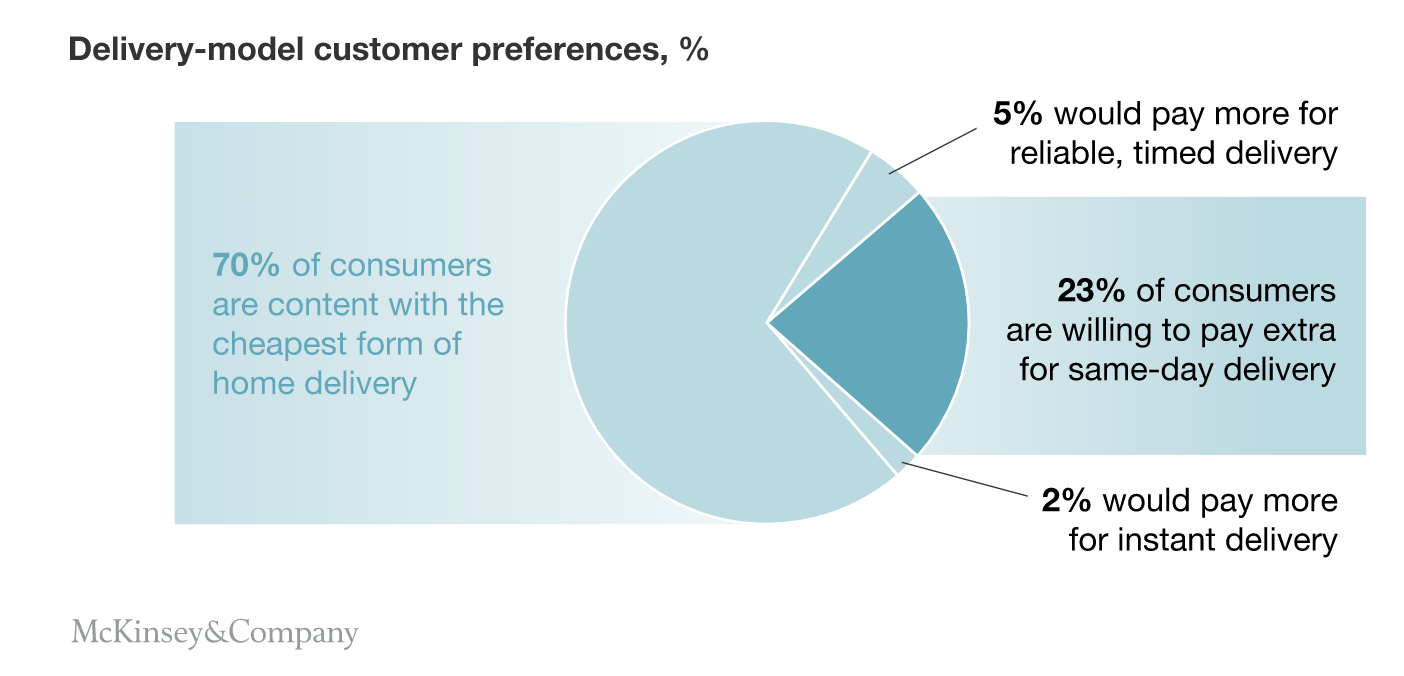Illustration by Jennifer Tapias Derch
For many retailers, online-to-offline ecommerce was the key to growth in 2020. The coronavirus pandemic pushed more consumers online—but for those still longing for in-store experiences, retailers needed to refine their online-to-offline (O2O) strategy to open their doors to online shoppers.
O2O commerce is a new retail strategy that turns ecommerce visitors into offline sales. But its effectiveness isn’t set to diminish once the COVID-19 pandemic ends.
This guide explains what an O2O commerce strategy looks like, the benefits of turning ecommerce traffic into offline sales, and how retailers can develop their own strategies.
O2O commerce definition
Online-to-offline commerce is a business strategy designed to bring potential customers from online channels to physical stores to make a purchase. It brings people from Instagram, email, and digital ads to a brick-and-mortar store.
It’s not to be confused with omnichannel, where customers go back and forth between online and offline channels. O2O commerce brings together techniques from online marketing and brick-and-mortar marketing. It turns ecommerce visitors into physical shoppers by:
Offering in-store pickup of products purchased online
Facilitating the purchase of products while at a physical store
Allowing online purchases to be returned to the retailer’s location
Considering that 87% of shoppers conduct online research before making purchases (up from 71% a year prior), channeling even a small percentage of their research to your offline store would represent massive revenue potential.
How does O2O commerce work?
At one point, retailers were concerned that because ecommerce stores sold online, they wouldn’t be able to compete on price and selection. Stores have high operating costs (employees, rent) and limited space, so they can’t offer a wide selection.
But the truth is, 80% of shoppers will go to the store to buy when they have an item they need or want immediately.
This drove retailers to treat physical and online channels as two different channels—complements, not competitors. The purpose of O2O commerce is to create awareness for products and services online, then visit the store to make a purchase. Techniques include home delivery, curbside pickup, and letting customers place orders through your online store to pick up in-store.
O2O commerce business model benefits
Give shoppers what they want
Modern day shoppers are savvy. They have millions of retailers to choose from. If you don’t deliver on their expectations and give them what they want, they’ll head to a competitor who will.
How does this fit with the O2O commerce model? Research shows that 61% of shoppers would rather shop with brands that also have a physical location (versus those that are online-only).
Brick-and-mortar shopping gives customers a chance to chat with sales reps, touch products in person, and get the in-store experiences that cause millennials to open their wallets.
Combine that in-store customer experience with an online strategy so shoppers can read detailed product descriptions without talking to a sales rep. They can use a mobile app to redeem points on a loyalty program and redeem social media coupons for money off in-store.
Reach more customers
An O2O commerce strategy means traditional retailers can reach more customers than those who just walk in the door.
Not everyone passing by your brick-and-mortar stores will pop in when they get a chance to do so. The vast majority (87%) of shoppers rely on the internet to research new products, turning to search engines, social media platforms, and review aggregators to help them decide what to buy.
When retailers use these online channels effectively, they can build niche audiences around their physical locations. This drives internet users toward brick-and-mortar stores—resulting in more foot traffic than if they were IRL-only.
This ability to reach more customers was a driving factor in Walmart's $3.3 billion acquisition of Jet.com. The legacy department retailer wanted to reach a new audience of city slickers and millennial customers. Jet.com had 400,000 new shoppers each month in that category, which Walmart could direct to its 11,000+ stores.
Ecommerce giant Alibaba also launched an O2O strategy—a physical store—in an attempt to capture the 80% of China’s $4.9 trillion retail sales that happen offline.
Using customer data such as brand membership information, purchasing history, and store visiting habits, Alibaba hopes to be able to adjust and personalize product offerings, create tailored marketing campaigns, and streamline supply chains.
Brand recognition and sales
These days, shopping journeys are anything but linear. Customers are always (and often subconsciously) shopping—especially when they’re online.
Retailers need an O2O commerce strategy that reaches them at those points, funneling potential customers from several online channels into its brick-and-mortar store.
According to Aspect Software, businesses that adopt an omnichannel strategy achieve a 91% year-over-year customer retention rate compared to those that don’t. Plus, retailers with a strong omnichannel customer engagement retain an average of 89% of their customers, compared to 33% of those with weak or no omnichannel customer engagement.
Save money on logistics
Ecommerce logistics often become more complex as you scale.
However, an O2O commerce strategy—especially the buy online, pick-up in-store model—helps merchants cut down logistical costs. Retailers can regionalize their inventory and dedicate a percentage of their store space toward storing products that have been sold online.
Doing this allows retailers to reduce their reliance on third-party logistics (3PL) partners. They can also confidently offer same- or next-day pick-up for customers since the products are already in-store.
O2O commerce market size and opportunities
O2O commerce allows you to go after both ecommerce and retail markets at the same time. Instead of brick-and-mortar retailers reaching just one type of shopper (those within close proximity to the store), they can reach the 2.14 billion digital buyers, too.
Retail sales are projected to reach $5.94 trillion by 2024. But while US consumers shopped equal amounts online and offline in 2021, ecommerce is set to take the lead on total retail sales.
Just over 10 years ago, ecommerce accounted for 5.1% of total US retail sales. Today, ecommerce sales now account for 21.3%.
Consumers spent $861 billion online in the US in 2020, up 44% from 2019. It’s the highest annual ecommerce growth in the past two decades, undoubtedly accelerated by the COVID-19 pandemic.

O2O commerce industry statistics and trends
Ecommerce giant Amazon already placed its bet on Whole Foods when it purchased the brick-and-mortar grocer for $13.7 billion in 2017. It blends both offline commerce and online sales: consumers can use their Amazon Prime credit card at Whole Foods and redeem 5% of the total amount on online purchases.
But maybe acquiring businesses for billions of dollars isn’t in your budget. There are still ways you can pivot to the O2O business model for your brand.
BOPIS
For many people, 2020 was a year when online shopping and curbside pickup replaced shopping in-store.
The COVID-19 pandemic caused many brick-and-mortar locations to temporarily close their doors. Yet when lockdowns started to ease and stores reopened, many consumers still had concerns about returning to complete in-store shopping normality.
Buy online, pickup in store (BOPIS) services help drive those online shoppers back to physical stores. Customers can use a retailer’s ecommerce site to browse products, purchase those they like, and receive a notification when it’s ready to collect from their local store.
Data shows three-quarters of consumers have used this type of curbside pick-up or BOPIS service in the last six months. To match that demand, more than 50% of large retail chains offered curbside pickup as of April 2021.

Make a dedicated space in your retail store for pickup orders to stay organized. Also, use the Shopify POS app to manage and mark orders available for pickup once they’re packed and ready to go. This way, the customer gets a notification that it’s ready.”
—Allison Mistakidis, co-founder of Whiskeyjack Boutique
Being able to order online and pick up an item in-store is not only convenient, it helps fulfill our need for instant gratification. In a world where the latest movies are available on demand and personal taxis can be called to our location within minutes, the ability to get things when we want them is now considered the norm.
For retailers, click-and-collect is a chance to bring online customers to offline stores. Once you have the customers in store, you have the opportunity to entice them to purchase other products.
Home delivery
The convenience of click-and-collect shopping has made it one of the retail industry’s biggest trends in the last few years.
While BOPIS is undoubtedly convenient for some, it’s not always the most popular method of getting products quickly. For consumers located in densely populated areas, driving to the store, navigating traffic, finding a parking spot, and loading up cumbersome products into the car can be an unattractive proposition…despite the benefits of instant gratification.
On the flip side, consumers located in sparsely populated areas might find the time and fuel costs associated with traveling to a retail location outweigh the benefits of click-and-collect shopping.
How do you walk that line?
McKinsey’s research found that 23% of consumers are willing to pay more for same-day delivery. In fact, the perceived reliability and timeliness of delivery is a major decision-making factor for customers and therefore directly affects a company’s success in O2O commerce.

One option is partnering with couriers like UPS and DHL to deliver purchased items to self-service lockers. Customers can search by zip code to find nearby lockers and stop by when they receive the notification that their order is ready to pick up.
Don’t want to work with a courier? Retailers can also do their own delivery to people within a certain radius of a store. Make sure you’re not putting too much pressure on your same-day delivery promise by restricting local delivery areas to specific postal codes. You should also limit the number of delivery orders per date and set preparation time rules.
Invest in local SEO
Did you know that 50% of people who used Google search before shopping looked for details about the store itself, such as locations or proximity? Not only that, 79% of holiday shoppers who visited a store turned to online search first.
A great deal of in-store shopping behavior derives from mobile users looking for three things:
Help to inspire a purchase
Help to plan the trip to the store (such as directions or nearby parking)
Help narrow down purchase options
Investing in local SEO can help potential customers find your business online during their search. The aim is to show up in local search results for terms like “fashion stores near me” and provide enough information to convince shoppers to visit your store.
Create a Google My Business listing for each location where you have a physical store. Optimize each listing to include opening hours, categories, photos, and minor details (like parking availability). Convincing existing customers to leave a review on your listing could be the deciding factor in whether people visit your brick-and-mortar store via search engines.
Add your products or in-store events to your Google My Business page. This will help capture no-click searches or when people are double-checking your address on Google.”
—Amy Falcione, founder of Big Picture Marketing
QR codes
People arriving at a retailer’s store still consult the web during their visit. Some 55% of shoppers use their smartphones to find product specifications. Another 40% check whether they’re eligible for exclusive offers.
QR codes, which look like bar codes, blend the O2O shopping experience. Retailers can place them in areas with high foot traffic—such as checkout desks and fitting rooms. Customers can scan these QR codes when they’re shopping at a physical location to:
Join a virtual queue outside the store
Retrieve their curbside pickup order
Redeem loyalty points on in-store purchases
Scan a product they’re returning through a mobile app
Participate in customer feedback surveys
O2O commerce examples
Magnolia Market
Magnolia Market is a DTC furniture retailer created by Fixer Upper’s Chip and Joanna Gaines. Its first brick-and-mortar store in Texas is more than a shopping location. It’s a literal pilgrimage for some, with the location reporting more annual visitors than the Alamo.
Magnolia Market wanted to give shoppers who couldn’t visit its flagship store a way to have the same experience. So, the retailer partnered with Shopify’s AR team to launch its O2O commerce strategy.
Now, online shoppers can use its app to see what a product looks like in the flesh. Or even better: what it would look like in their own home. If a customer is impressed, they’re incentivized to visit the store to buy.
“Across the board, we want to make sure that we do express those finer details of the in-store experience online. And so augmented reality, obviously as it pertains to Shopify, really makes that possible.”
—Stone Crandall, Digital Experience Manager at Magnolia
Beauty Heroes
Prior to working on its O2O commerce strategy, Beauty Heroes’ ecommerce sales were soaring. So much so, it decided to crack the offline market and open its first brick-and-mortar store in Novato, California.
Beauty Heroes used Shopify POS to aggregate sales data across both online and offline channels. It also encouraged existing customers to shop in-store by delivering targeted promotions based on purchase history.
Allbirds
Shoe retailer Allbirds’ journey to blend ecommerce and brick-and-mortar was fast. It went from experimenting with pop-ups to opening locations all over the world—including San Francisco, London, and Seoul.
A key part of Allbirds’ O2O strategy means anyone visiting one of its 20+ physical stores doesn’t have to leave empty handed if a product isn’t in stock. Allbirds uses Shopify’s POS to process the transaction then and there, taking payment for the product and shipping it to the customer as soon as it’s available.
[Buy in-store, ship to customer] allows for a much higher conversion than if we tell them to go back to their home and order it when they get back.”
—Travis Boyce, Head of Global Retail Operations, Allbirds
A summary of O2O commerce in 2021
There are numerous opportunities for retailers to combine online and offline commerce into a complementary shopping experience—one that keeps customers satisfied and increases profits.
And if companies like Amazon and Alibaba consider O2O commerce to be the next step in their ecommerce development, you can be sure that it will be good for the development of your business as well.
Read more
- How I Raised $1.1 Million Without a Network or Experience
- Reimagining Racial Equity in the Fashion Industry
- What Is Ecommerce Automation? Save Costs and Focus on What Matters
- The Death of Advertising as We Know It
- Artificial Intelligence: Armageddon or Nirvana? Experts Predict What Happens Next
- Consumer Psychology: Sell to the Person Behind the Persona
- The Dirty Little Secret Traditional Enterprise Software Companies Don't Want You Knowing
- Warning: Most Conversion Optimization Tips Are BS (Here's Why!)
Online-to-Offline (O2O) FAQ
What is an O2O strategy?
An O2O strategy is the process of driving online customers toward a physical store. As part of their strategy, retailers use social media, content marketing, and display advertising to target local customers. The aim is to incentivize them to visit a brick-and-mortar store to make the purchase (or collect one they’ve made online.)
Why is O2O important?
O2O is important because modern shopping journeys are complex. Research shows that people use the internet to help make product decisions—including whether they should buy an item from a store in their local area.
Offline businesses need an online strategy to drive people to their brick-and-mortar locations. Similarly, ecommerce stores that are online-only can open physical stores for customers to see, touch, and interact with their products in the flesh.
What is the difference between O2O and B2B ecommerce?
Business-to-business (B2B) ecommerce happens when one company buys from another. O2O companies use online channels to drive customers toward their brick-and-mortar locations.
B2B and O2O aren’t mutually exclusive. Retailers selling to other companies can still have an O2O strategy. In this case, the retailer uses digital marketing to convince its B2B customers to visit a store, pop-up, or trade show.


